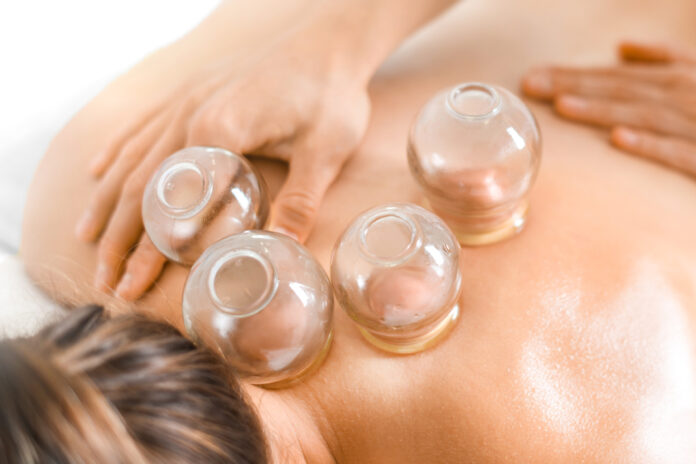- Mikyung Kim(1Department of Internal Medicine, College of Korean Medicine, Sangji University), Chang-ho Han(Department of Internal Medicine, College of Korean Medicine, Dongguk University)
- J Korean Med. 2021;42(4):75-101
2. RoB of the included studies
Only two studies15,24) which provided enough information to confirm that both the random sequence generation and allocation concealment process were properly performed, met the first domain of the RoB 2 (randomization process). The remaining included studies did not provide enough information to judge relevant procedures and were judged to be at the level of raising some concerns in this domain.
In the second domain, deviations from the intended interventions, all studies were judged to be at low RoB. Although patient blinding and performer blinding were not performed, it was judged that this situation was due to the unique nature of the cupping therapy and would not have affected the intended intervention.
In the third domain, missing outcome data, most studies were judged to be at high RoB. This was because they did not mention anything about loss to follow-up or dropout and we could not rule out the possibility that any missingness led to
biased results. Only 3 studies15,18,24) reported dropout, and we could confirm that the missingness did not bias the results, these studies were judged to be at low RoB.
In the fourth domain, measurement of the outcome, all the included studies were judged to be at high RoB. This was because no studies mentioned anything about the achievement or impact of assessor blinding.
In the fifth domain, selection of the reported result, we judged that some concerns were raised in the RoB of all included studies. No studies involved previously published study protocol papers prior to initiation of trial. Therefore, we reviewed whether the results session was described in accordance with the plans mentioned in the Methods section of the paper. No significant biases were identified in the Methods and Result sections. However, no studies provided information that could confirm whether the reported outcome was selected from among multiple outcome measurements, and therefore, this issue raised some concerns for all included studies. The overall RoB of all included studies derived by synthesizing the evaluations in the above domains was judged to be high. The results of the RoB assessment for each domain of the included studies are schematically shown in Supplements 5 and 6.
3. Meta-analysis and evidence level

1) Effectiveness of cupping therapy compared to Western medication Two studies17,24) compared the effect of wet cupping therapy with Western medication (baclofen 10 mg tid pc [P.O.]) in patients with upper limb spasticity after stroke. The meta-analysis of these two studies showed that cupping therapy was significantly more advantageous in improving upper limb dysfunction assessed by the subdomain score of the FMA scale (MD 5.20, 95% CI 1.51 to 8.88, P=0.006) (Fig. 2).

The degree of spasticity assessed by the modified Ashworth scale (MAS) was also significantly improved in the cupping therapy group compared to the Western medication group (MD -0.69, 95% CI -0.82 to -0.56, P<0.00001) (Fig. 3(A)). The proportion of patients who responded positively regarding the clinical aspects of spasticity was also significantly higher in the cupping group (MD 3.81, 95% CI 1.50 to 9.65, P=0.005) (Fig. 3(B)). Changes in the biceps and triceps muscles detected by integrated electromyography were also more favorable with cupping therapy (MD -4.05, 95% CI -6.36 to -1.74, P=0.0006; MD=3.56, 95% CI 1.62 to 5.50, P=0.0003) (Fig. 3(C, D)). The certainty of the evidence assessed by the GRADE approach was low in all cases. This was because of the high RoB and small sample size of the included studies (Supplement 7). (To Be Continued.)
References
- 15. Jiang, L. (2018). The Curative Effect of Acupuncture and Cupping Therapy on Upper Limb Dysfunction of Stroke Xinjiang Medical University [Master’s thesis].
- 16. Huang, Z., Zhao, N., Su, Z., Su, J., & Wu, Q. (2018). Effects of pricking and cupping combined with rehabilitation training on elbow flexion spasticity of upper limb after stroke and its IEMG value. Chinese Acupuncture & Moxibustion, 38(2), 119-124. doi: 10.13703/j.0255-2930.2018.02.002.
- 17. Chen, J., Lin, S. (2017). The clinical effect of pricking and cupping combined with rehabilitation training in the treatment of stroke patients with upper limb elbow flexion spasm. Chinese Journal of Medical Device, 30(15), 121-122.
- 18. Chen, Y. P. (2017). Clinical Research on Hemidysesthesia After Stroke Treated by Acupuncture combined with Collateral-Needling Cupping. Henan Traditional Chinese Medicine, 37(1), 87-89. doi: 10.16367/j.issn.1003-5028. 2017.01.0029.
- 19. Liu, H., Liu, T., & Wang, Z. (2016). Effect of acupoint injection combined with cupping treatment on the daily life ability of patients with shoulder pain after stroke. Chinese Community Doctors, 32(27), 169-170. doi: 10.3969/j.issn.1007-614x.2016.27.108. 20. Zhang, B. (2016). The Clinical Observation of Body Spasm After Stroke Applying The Therapy of Combination Acupucture With Pricking and Cupping. Shandong University of Traditional Chinese Medicine [Master’s thesis].
- 21. Cheng, X., Cheng, C. (2014). Cupping combined Conventional Symptomatic Treatment and Rehabilitation Training after Stroke Shoulder – hand Syndrome Randomized Parallel Group Study. Journal of Practical Traditional Chinese Internal Medicine, 28(11), 27-29. doi: 10.13729/j.issn.1671-7813.2014.11.12.
- 22. Zhang, Q., Wei, Z., Cui, Y. (2014), Bloodletting and cupping combined with exercise therapy to treat 31 cases of stroke and hemiplegia and shoulder pain.. Hebei Journal of Traditional Chinese Medicine, 36(4), 568-569.
- 23. Miao, T. (2014). MOTOmed intelligent exercise system combined with blood pricking and cupping for treatment of increased muscle tone of lower limbs in stroke patients. Practical Journal of Medicine and Pharmacy, 31(3), 214-215. doi: 10.14172/j.cnki.issn1671-4008.2014.03.007.
- 24. Huang, Z. (2014). Effect of Pricking Blood with Cupping Therapy Combined with Rehabilitation Training on the Spasticity of the Upper Limb in Patients with Stroke. Fujian University of Traditional Chinese Medicine [Master’s thesis].



































